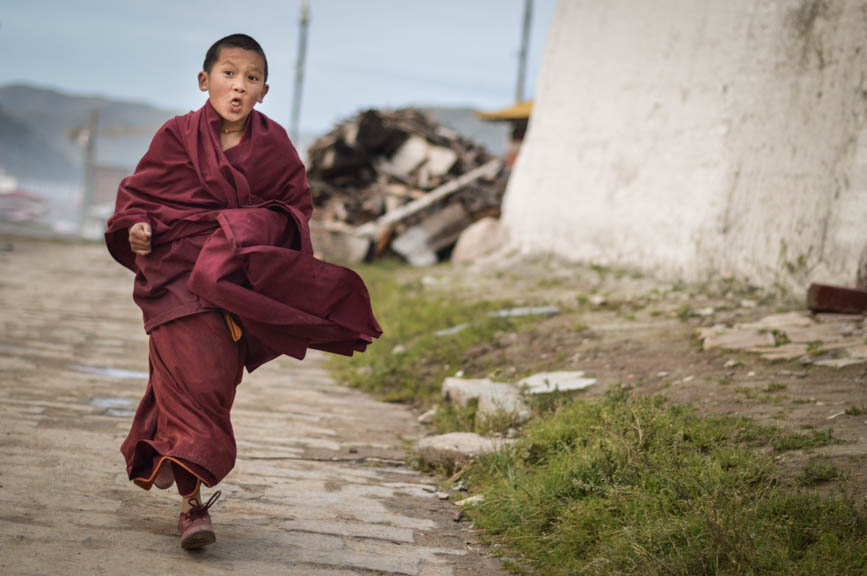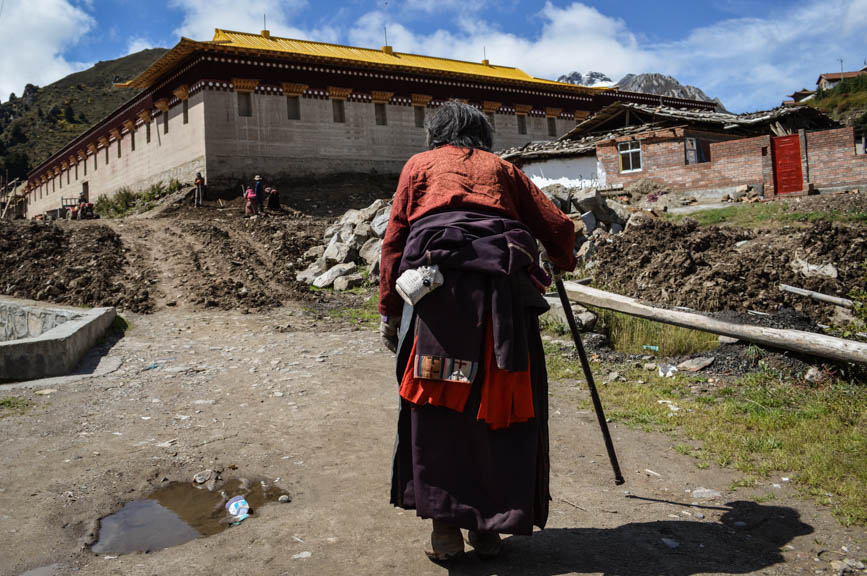What lies behind the gorge in Langmusi

Nature, always inartistic, takes pleasure in creating the impossible.
– Jerome K. Jerome
I can no longer tell if the white smoke is from my own breath or the million chimneys that surround us. Billowing fumes fight against the frosty air and warm patches of wet grass seem to be steaming from the ground up. It is freezing in Langmusi. The kind of humid cold that penetrates your bones and stops the circulation in your fingertips and toes no matter how many layers of wool you have wrapped them in. At 3345m, the road to Langmusi was grey and smooth, the charcoal clouds hanging so low we could have reached them from the windows of Tonzing’s car.
It is the kind of weather which knows no time of day, looking the same at 10 in the morning or 4 in the afternoon. Unrelenting and flat. The snowy peaks surrounding the small town warn us of an even colder night.
Langmusi in Chinese means “Langmu Temple”, but its Tibetan name “Taktsang Lhamo སྟག་ཚང་ལྷ་མོ་“ tells a richer story. “Taktsang” meaning “Tiger Cave” and “Lhamo” meaning “fairy”, named after the fairy that was found in the village caves of ancient legends. The White Dragon River that runs through the town provides a natural border between the Chinese provinces of Gansu and Sichuan, the towns’ two monasteries straddling each side of its banks.
That first evening, we follow some pilgrims up a hillside dirt road and end up in the Kirti Gompa – the monastery on the Sichuan side. Its narrow alleys twist and turn to form a village of their own, brick-based and wood-embellished houses tightly squished together to keep the heat in. Monks in crimson and burgundy robes are shuffling back and forth in slippers, their bare feet immune to the bitter chill. Some are spinning prayer wheels as they chat, others engrossed in deep conversations.


There are baby monks! OK, not babies, but young children racing to their classes, notebooks gripped tightly against their chest as they hold up folds of fabric to avoid tripping on their way. This village is more alive than any other monastery I have been to, pulsing with normal life, quiet and serene, but busy.
An empty path leads up towards one of the main monasteries, its terraces and doors cloaked in large black cloths embroidered with white swastikas, a symbol for eternity and good fortune. We are alone as we look down to the main street of Langmusi, one side lined with creamy yellow buildings, all stamped with the green Hui Muslim emblem and the dome of the Hui Mosque, poking out from the roofs of its neighbouring buildings. Langmusi is yet another example of the rich cultural and religious mix that inhabits these mountain areas of Gansu and Sichuan.
As evening descends, we return to the warmth of an indoor cafe filled with monks busy on their iphones and none of us can keep our eyes open, bodies tired from fighting the cold, suddenly give up and long for sleep.

The next morning, it is nothing but white outside our windows, a deep fog has come to wake up the town, making it much harder to roll out from under a sleeping bag and three layers of blankets. But we have been told about a gorge. A gorge we are determined to find.
By mid-morning, the fog miraculously lifts and the town turns from dusky to splashy. The dark bronze prayer wheels are now tinged in pink, turquoise and various shades of coral. The golden edged roofs of the monasteries glimmer in the sunlight. The grey mountains are now rich with greens, red and browns. The route to the Lhamo Gorge passes through the edge of the Kirti Gompa, behind its houses and new temple construction sites where two deer seem to hang out. Just two “Bambi” chilling in the open, walking around piles of construction material oblivious to the people around them. The surreal part of the hike has just started.



The entrance to the gorge is draped in faded prayer flags, the sun rays creeping through the cracks to illuminate colourful wall paintings in script we cannot read. An icy river runs through it and we cross a tiny bridge suspended like a leather belt over the rocks. A chinese couple warns us that it will get wetter, but that it is worth it. My excitement builds as we shadow the vertical rocks lining the rushing water, they told us about valleys and grasslands that lie behind, but I cannot imagine what it would look like as we clung tightly to the narrow crevices and balanced on the damp rocks.


Against the current we continue upwards, climbing slowly, occasionally tiptoeing over rocks in the water to cross to the other side where the path continues and suddenly the track widens. No longer in the shadows, the blue sky illuminates the steep rocks on either side of us. Silver rocks carpeted over by fluffy autumn colour bushes, dark green pine trees and poppy red poison berries.


We look up in awe, our steps with an extra bounce in them as we navigate deeper into the valley. This does not look like the China I know, the China I imagined. A part of China all to ourselves.
Passing through one last gap in the narrow gorge, a wide grassland appears, towered over by Karst-landscape peaks. The kind of open space that pushes you to burst out running and laugh out loud. I pass out on the grass to soak in the warm sun as Nico and our new road-trip-partner-in-crime, Marc race around taking photos, all of us ecstatic to have reached the much talked about grassland. Wondering if this was the end point, Nico climbs over some rocks at the edge of the grassland to take a peek of what lay beyond.


It is always worth walking further.
Our jaws dropped in unison and there was a second of silence before the shouts. There is no other word for it but WOW.
An immense valley laughs at our gaping faces. Sharp rocks are shooting out of the earth and every element looks like it came from a far away place, but somehow they have all been plucked from their native land and delicately placed together here. One slope African bush yellow, the other Canada red sliding towards each other with Irish green grass layered in the middle surrounded by glistening snow-capped Dolomiti peaks.
We are alone. Completely alone and the only sound is of rushing water and the echoes of birds’ cries.
This is why we travel. To discover somewhere unexpected, untouched and undiscovered. A place so beautiful yet unknown that has not been transformed into a Google image yet.

We reluctantly turn back after a small picnic and find furry cows that look like a marriage of yak and sheep enjoying the fat leaves of the grassland. They remind me of the purple “Milka” chocolate cows and Marc who is Swiss says, “Mamma, look I am home!” from behind his camera lenses.
The clouds start to thread candy floss in the sky as they get ready for the afternoon sun. The canary yellow bushes turn from amber orange to rusty gold.


Emerging from the gorge, we say goodbye one last time to its mystical fairies and tigers and head back to town elated. The Kirti Gompa is lively with afternoon pilgrimages enjoying the last rays of the day as we cross it to get to the other side of the river where the Sertri Gompa sits. Up on a steep hill, the Sertri Gompa is quieter, the streets deserted save for a pop-up corner stall selling velvet black monk boots from the trunk of a car and a sedan full of monks zipping past us up the hill towards the highest monastery.


Children coming home from school greet us along the way, some cheeky some sweet, bursting into easy giggles whenever Nico tries to say a word in Chinese. They challenge him with tongue twisters such as “Qishiqi” – “77” in Chinese before waving “goodbyeee!” and running off to their dinners.


As the sun sets further, the whisky-coloured roofs and stupas of Langmusi shine further gold as the town gets ready for the cold again. A valley named after ancient legends that has managed to hold on to its magic.







4 Comments
Giuliano Venezia
October 11, 2014beautiful travel reporting and beautiful photos
Nico & Gabi
October 13, 2014Grazie Giuliano!
tammy
October 11, 2014Love the scenery! The colour and the children!
Kristen
October 12, 2014Wow! Love the kids and the hairy cows. And especially love that scenery. Would love to hike there. One to add to the ever growing list of places to go!